

Joseph Goebbels - Vikipedi. Goebbels ailesi: ön sıra, soldan sağa: Helmut, Hedwig, Heidrun, Joseph, Holdine, ortada: Magda, arka sıra, soldan sağa: Hildegard, Harald Quandt (Günther Quandt ve Magda'nın oğlu) ve Helga Dr.
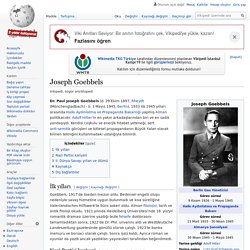
Paul Joseph Goebbels (d. 29 Ekim 1897, Rheydt (Mönchengladbach) - ö. 1 Mayıs 1945, Berlin), 1933 ilâ 1945 yılları arasında Halkı Aydınlatma ve Propaganda Bakanlığı yapmış Alman politikacıdır. Adolf Hitler'in en yakın arkadaşlarından biri ve en sadık yandaşıydı. Kendisi coşkulu ve enerjik hitabet yeteneği, sert anti-semitik görüşleri ve kitlesel propagandanın Büyük Yalan olarak bilinen tekniğini kullanmadaki ustalığıyla bilinirdi. İlk yılları[değiştir | kaynağı değiştir] Goebbels, 1917'de liseden mezun oldu. Nazi Partisi kariyeri[değiştir | kaynağı değiştir] 1933 yılında Nazilerin iktidara gelmelerinin ardından 13 Mart 1933'te Propaganda Bakanı oldu. II. Joseph Goebbels. Nazi politician and Propaganda Minister Paul Joseph Goebbels (German: [ˈpaʊ̯l ˈjoːzɛf ˈɡœbl̩s] ( listen);[1] 29 October 1897 – 1 May 1945) was a German Nazi politician and Reich Minister of Propaganda of Nazi Germany from 1933 to 1945.
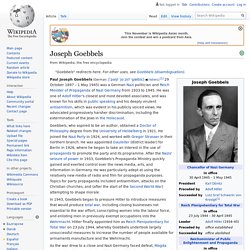
He was one of Adolf Hitler's closest and most devoted associates, and was known for his skills in public speaking and his deeply virulent antisemitism, which was evident in his publicly voiced views. He advocated progressively harsher discrimination, including the extermination of the Jews in the Holocaust. Goebbels, who aspired to be an author, obtained a Doctor of Philosophy degree from the University of Heidelberg in 1921. In 1943, Goebbels began to pressure Hitler to introduce measures that would produce total war, including closing businesses not essential to the war effort, conscripting women into the labour force, and enlisting men in previously exempt occupations into the Wehrmacht. NEF’Î - kainatingunesi.com. On yedinci yüzyıl dîvân şâirlerinin önde gelenlerinden. 1572 senesinde Erzurum’un Hasankale ilçesinde doğan şâirin asıl adı Ömer’dir.
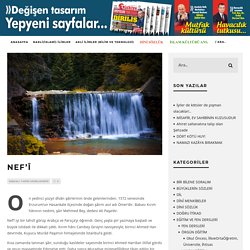
Babası Kırım hânının nedimi, şâir Mehmed Bey, dedesi Ali Paşa’dır. Nef’î iyi bir tahsîl görüp Arabça ve Farsça’yı öğrendi. Genç yaşta şiir yazmaya başladı ve büyük istidadı ile dikkati çekti. Bengal famine of 1943. Famine in British India during World War II The Bengal famine of 1943 (Bengali: পঞ্চাশের মন্বন্তর pônchasher mônnôntôr) was a major famine of the Bengal province[B] in British India during World War II.

An estimated 2.1–3 million,[A] out of a population of 60.3 million, died of starvation, malaria, or other diseases aggravated by malnutrition, population displacement, unsanitary conditions and lack of health care. The crises overwhelmed and impoverished large segments of the economy and social fabric. Historians have frequently characterised the famine as "man-made",[C] asserting that wartime colonial policies created and then exacerbated the crisis.
A minority view holds that the famine arose from natural causes. Bengal's economy had been predominantly agrarian when between half and three-quarters of the rural poor lived in a "semi-starved condition". Hikmah. Hikmah (also Hikmat, Arabic: حكمة, ḥikma, literally wisdom, philosophy; rationale, underlying reason,[1]) is a concept in Islamic philosophy and law.
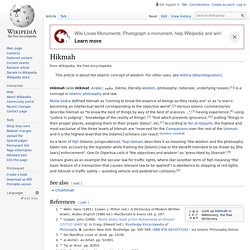
Mulla Sadra defined hikmah as "coming to know the essence of beings as they really are" or as "a man's becoming an intellectual world corresponding to the objective world".[2] Various Islamic commentaries describe hikmah as "to know the best of things by way of the best of sciences ... ",[3] having experience,[4] using "justice in judging", "knowledge of the reality of things",[5] "that which prevents ignorance,"[6] putting "things in their proper places, assigning them to their proper status", etc.[7] According to Ibn al-Qayyim, the highest and most exclusive of the three levels of hikmah are "reserved for the Companions over the rest of the Ummah, and it is the highest level that the [Islamic] scholars can reach.
"[citation needed] See also[edit] Chokhmah. Ehl-i Dildir Diyemem Sinesi Saf Olmayana - Genel. Nef'i - Vikipedi. Nef'î, (Osmanlı Türkçesi: نفعي), (d. 1572, Hasankale, Erzurum – ö. 27 Ocak 1635, İstanbul), 17. yüzyıl Türk şâirlerindendir.
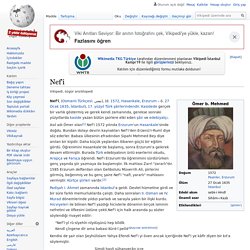
Kasidede gerçek bir varlık göstermiş ve gerek kendi zamanında, gerekse sonraki yüzyıllarda kaside yazan bütün şairlere etki eden şâir ve edebiyatçı. Asıl adı Ömer olan[1] Nef'i 1572 yılında Erzurum'un Hasankale'sinde doğdu. J. Robert Oppenheimer. American theoretical physicist, known as "father of the atomic bomb" J.
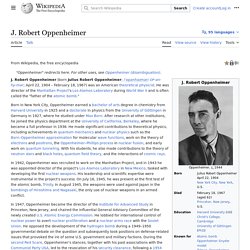
Robert Oppenheimer[note 1] (; April 22, 1904 – February 18, 1967) was an American theoretical physicist and professor of physics at the University of California, Berkeley. Oppenheimer was the wartime head of the Los Alamos Laboratory and is among those who are credited with being the "father of the atomic bomb" for their role in the Manhattan Project, the World War II undertaking that developed the first nuclear weapons. The first atomic bomb was successfully detonated on July 16, 1945, in the Trinity test in New Mexico. Oppenheimer later remarked that it brought to mind words from the Bhagavad Gita: "Now I am become Death, the destroyer of worlds After the war ended, Oppenheimer became chairman of the influential General Advisory Committee of the newly created United States Atomic Energy Commission.
Early life. Masonluk ve Masonlar - Masonluk, Masonlardan Öğrenilmelidir. Masonluk - Vikipedi. Masonluğun gönye ve pergelin ortasında yer alan G harfinden oluşan geleneksel amblemi.
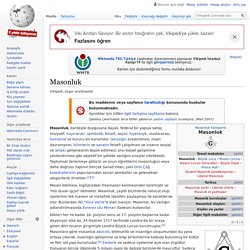
Freemasonry. Group of fraternal organizations Freemasonry or Masonry consists of fraternal organisations that trace their origins to the local fraternities of stonemasons that from the end of the 14th century regulated the qualifications of stonemasons and their interaction with authorities and clients.
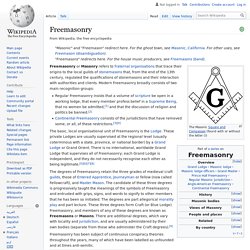
Freemasonry has been the subject of numerous conspiracy theories throughout the years.[1] Modern Freemasonry broadly consists of two main recognition groups: The basic, local organisational unit of Freemasonry is the Lodge. These private Lodges are usually supervised at the regional level (usually coterminous with either a state, province, or national border) by a Grand Lodge or Grand Orient. Vezn-i Âhar - Vikipedi. Vezn-i Âhar ya da Vezni Aher, Halk şiiri nazım şeklidir.

Aruzun müstef’ilâtün müstef’ilâtün müstef’ilâtün müstef’ilâtün kalıbıyla murabba şeklinde yazılır. Her mısra bir müstef’ilâtün cüzüne sığacak şekilde dört kelime veya kelime grubuna bölünür. Birinci mısranın 2. SANMA ŞÂHIM HERKESİ SEN SÂDIKÂNE YÂR OLUR. .Sanma şâhım herkesi sen sâdıkâne yâr olur Herkesi sen dost mu sandın belki ol ağyâr olur Sâdıkâne belki ol bu âlemde dildâr olur Yâr olur ağyâr olur dildâr olur serdâr olurYavuz Sultan Selim Yavuz Sultan Selim’in yazdığı bu şiirin özelliği; soldan sağa ve yukarıdan aşağı okunduğunda mısraların aynı olmasıdır. Noble Eightfold Path. An early summary of the path of Buddhist practices leading to liberation from samsara The eight spoke Dharma wheel symbolizes the Noble Eightfold Path. Dharma.
Key concept in Indian philosophy and Eastern religions, with multiple meanings Dharma (;[7] Sanskrit: धर्मः, romanized: dharma, pronounced [dʱɐrmɐ] ( listen) (Pali : dhamma)) is a key concept with multiple meanings in many religions, such as Hinduism, Buddhism, Jainism, Sikhism and others.[8] There is no single-word translation for dharma in Western languages.[9] Etymology[edit] The word dharma takes the meaning of "what is established or firm", and hence "law".
It is derived from an older Vedic Sanskrit n-stem dharman-, with a literal meaning of "bearer, supporter", in a religious sense conceived as an aspect of Rta. Arya (Buddhism) The term is used in the following contexts: The Four Noble Truths are called the catvāry ārya satyāni (Sanskrit) or cattāri ariya saccāni (Pali).The Noble Eightfold Path is called the ārya mārga (Sanskrit, also āryāṣṭāṅgikamārga) or ariya magga (Pāli).Buddha's Dharma and Vinaya are the ariyassa dhammavinayo.In Buddhist texts, the āryas are those who have the Buddhist śīla (Pāli sīla, meaning "virtue") and follow the Buddhist path.Buddhists who have attained one of the four levels of awakening (stream-entry, once-returner, non-returner, arahant) are themselves called ariya puggalas (Arya persons).
In the context of the four noble truths, contemporary scholars explain the meaning of ārya as follows: The word "noble," or ariya, is used by the Buddha to designate a particular type of person, the type of person which it is the aim of his teaching to create. In the discourses the Buddha classifies human beings into two broad categories. Alex Faickney Osborn. Alex Faickney Osborn (May 24, 1888 – May 5, 1966) was an advertising executive and the author of the creativity technique named brainstorming.
Founding of BBDO[edit] In 1919, Osborn joined with Bruce Fairchild Barton and Roy Sarles Durstine to form the BDO advertising agency. Osborn acted as manager of BDO's Buffalo branch. Cybernetics. Cybernetics is a transdisciplinary[1] approach for exploring regulatory systems, their structures, constraints, and possibilities. Cybernetics is relevant to the study of systems, such as mechanical, physical, biological, cognitive, and social systems. Cybernetics is applicable when a system being analyzed incorporates a closed signaling loop; that is, where action by the system generates some change in its environment and that change is reflected in that system in some manner (feedback) that triggers a system change, originally referred to as a "circular causal" relationship.
Some say this is necessary to a cybernetic perspective. Boolean algebra. Boolean algebra was introduced by George Boole in his first book The Mathematical Analysis of Logic (1847), and set forth more fully in his An Investigation of the Laws of Thought (1854).[1] According to Huntington the term "Boolean algebra" was first suggested by Sheffer in 1913.[2] Boolean algebra has been fundamental in the development of digital electronics, and is provided for in all modern programming languages. Henri Poincaré. French mathematician, physicist, engineer, and philosopher of science Jules Henri Poincaré (,[4] ;[5][6][7] French: [ɑ̃ʁi pwɛ̃kaʁe] ( listen);[8][9] 29 April 1854 – 17 July 1912) was a French mathematician, theoretical physicist, engineer, and philosopher of science.
He is often described as a polymath, and in mathematics as "The Last Universalist",[10] since he excelled in all fields of the discipline as it existed during his lifetime. As a mathematician and physicist, he made many original fundamental contributions to pure and applied mathematics, mathematical physics, and celestial mechanics.[11] In his research on the three-body problem, Poincaré became the first person to discover a chaotic deterministic system which laid the foundations of modern chaos theory. Vishnu.
Vishnu's eternal and supreme abode beyond the material universe is called Vaikuntha, which is also known as Paramdhama, the realm of eternal bliss and happiness and the final or highest place for liberated souls who have attained Moksha. Vaikuntha is situated beyond the material universe and hence, cannot be perceived or measured by material science or logic.[5] Vishnu's other abode within the material universe is Ksheera Sagara (the ocean of milk), where he reclines and rests on Ananta Shesha, (the king of the serpent deities, commonly shown with thousand heads).
Pranayama. Practice of breath control in Yoga Group of people practicing Prāṇāyāma Pranayama is the practice of breath control in yoga. In modern yoga as exercise, it consists of synchronising the breath with movements between asanas, but is also a distinct breathing exercise on its own, usually practised after asanas. In texts like the Bhagavad Gita and the Yoga Sutras of Patanjali, and later in Hatha yoga texts, it meant the complete suspension of breathing.
SOLAK KEDİ. Hâsılım yok ser-i kûyunda belâdan gayrı Garâzım yok reh-i aşkında fenâdan gayrı Ney-i bezm-i gamem ey âh ne bulsan yele ver Oda yanmış kuru cismimde hevâdan gayrı Perde çek çehreme hicrân günü ey kanlı sirîşk Ki gözüm görmeye ol mâh-likâdan gayrı. Batiniyya. Sunni writers have used the term batiniyya polemically in reference to rejection of the evident meaning of scripture in favor of its bāṭin meaning.[2] Al-Ghazali, a medieval Sunni theologian, used the term batiniyya pejoratively for the adherents of Isma'ilism.[2][4] Some Shia writers have also used the term polemically.[1] Al-Insān al-Kāmil. Şikâyetnâme - Vikipedi. Şikâyetnãme (Osmanlıca: شکايت نامه) Fuzûlî'nin en önemli eserlerinden biridir. Kanuni Sultan Süleyman 1534 yılında Bağdat'ı fethettikten sonra Fuzûlî Osmanlı sarayının hizmetine girmiş ve padişaha kasideler sunmuştur. Padişah tarafından beğenilen kasideler karşılığında da 9 akçelik maaşla ödüllendirilmiştir.
Fuzûlî - Vikipedi. İştikak Sanatı Nedir. Ömer Hayyam - Vikipedi. Rudyard Kipling. Kamusu Riyaziyat (Osmanlıca) - Merhum Salih Zeki. Kamus-u riyaziyat. Yunus Emre - Vikipedi. Mysticism. Golden Temple, Sripuram.